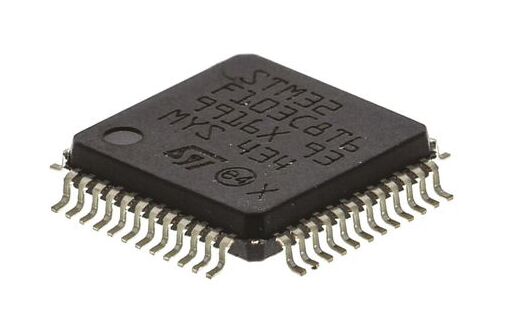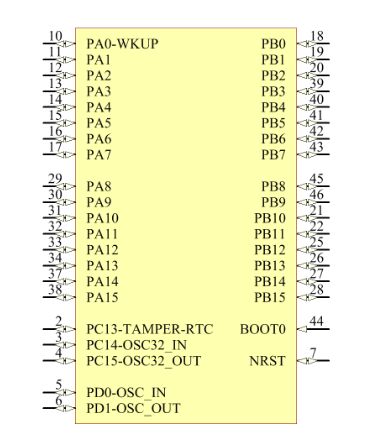By STMicroelectronics 190
STM32F103C8T6 uses a high-performance ARM® Cortex™-M332-bit RISC core with an operating frequency of 72MHz, built-in high-speed memory (up to 128K bytes of flash memory and 20K bytes of SRAM), rich enhanced I/O ports and connections to two APB bus peripherals.

Ⅰ.Specifications of STM32F103C8T6
•Number of pins:48
•Frequency:72MHz
•Products:MCUs
•Oscillator type:Internal
•Maximum frequency:72MHz
•Height:1.4 mm
•Length:7 mm
•Width:7 mm
•Package:Tray
•Number of SPI channels:2
•Number of PWM channels:1
•Number of programmable I/Os:48
•Nominal supply current:1.7µA
•REACH Compliant:Yes
•EU RoHS Compliant:Yes
•China RoHS Compliant:Yes
•ADC resolution:12 bit
•Package/Case:LQFP-48
•Program memory size:64 kB
•Data bus width:32 bit
•Installation style:SMD/SMT
•Program memory type:Flash
•Data converter:A/D 10x12b
•Product Category:ARM Microcontroller-MCU
•Maximum clock frequency:72 MHz
•Number of input/output terminals:37 I/O
•Data RAM size:20 kB
•Supply voltage-Minimum:2 V
•Supply voltage-Max:3.6 V
•Minimum operating temperature:-40℃
•Maximum operating temperature:+85℃
•Number of ADC channels:10 Channel
•Number of timers/counters:3 Timer
•Processor family:ARM Cortex M
•Product type:ARM Microcontrollers-MCU
•Connectivity:CANbus, I2C, IrDA, LINbus, SPI, UART/USART, USB
Ⅱ.Features of STM32F103C8T
•7-channel DMA controller, 3 general-purpose timers and 1 advanced control timer
•2 SPI, 2 I2C, 3 USART, 1 USB and 1 CAN interface
•Up to 80 fast I/O ports:26/37/51/80 I/Os, all mappable on 16 external interrupt vectors and almost all 5 V-tolerant
•Memories
-20 Kbytes of SRAM
-64 or 128 Kbytes of Flash memory
•Two 12-bit, 1μs A/D converters (up to 10 channels)
•Debug mode:Serial wire debug (SWD) and JTAG interfaces
•CRC calculation unit, 96bit unique ID
•Clock, reset and supply management
-32 kHz oscillator for RTC with calibration
-POR,PDR, and programmable voltage detector(PVD)
-PLL for CPU clock
-Internal 8 MHz factory-trimmed RC
Ⅲ.Pin diagram of STM32F103C8T6

Ⅳ.Working principle of STM32F103C8T6

1.Processor architecture: STM32F103C8T6 adopts ARM Cortex-M3 processor architecture. It is a 32-bit RISC architecture designed to provide high performance, low power consumption and compact code execution. The Cortex-M3 processor is based on the Harvard architecture and has separate instruction and data buses to improve execution efficiency.
2.Clock and power management: STM32F103C8T6 manages operating frequency and power consumption through clock and power modules. It supports internal and external clock sources and can be configured to suit different application scenarios. The power management module allows the microcontroller to enter low-power modes when needed to reduce power consumption and extend battery life.
3.Memory: STM32F103C8T6 has 512KB of flash memory and 64KB of SRAM, which are used to store program code and data. Program code and data are organized in a 4GB linear address space and stored in little-endian format. The address space is divided into 8 main blocks of 512MB each.
4.Communication protocol: STM32F103C8T6 supports multiple communication protocols, such as CAN, USB, etc. These communication protocols enable the STM32F103C8T6 to exchange data and communicate with other devices or systems.
5.Peripheral interfaces: STM32F103C8T6 has a variety of peripheral interfaces, including multiple timers, serial communication ports, SPI, I2C, etc. These peripheral interfaces enable the STM32F103C8T6 to communicate and control external devices.
Ⅴ.Advantages of STM32F103C8T6
1.Rich software support: Using ARM Cortex-M3 core, it supports a variety of development tools and software packages, such as Kel, IAR, CubeMX, etc., with high development efficiency.
2.High performance: Working frequency is up to 72MHz, with high-performance computing and floating-point computing capabilities, suitable for real-time applications and computing-intensive applications.
3.High cost-effectiveness: High cost-effectiveness, can better meet the needs of economical and affordable applications, and can be widely used in many fields, such as smart homes, Internet of Things, embedded systems, etc.
4.Low power consumption: It has a variety of built-in low power consumption modes, including standby, hibernation, shutdown, etc., which can effectively extend battery life and is suitable for low power consumption application scenarios.
5.Rich peripherals: Multiple built-in peripherals, such as up to 39 GPIO, UART, SPI, 12C, timer, PWM, etc., can adapt to different application scenarios.
Ⅵ.Application fields of STM32F103C8T6
1.Electronic equipment: Due to its flexibility and performance, STM32F103C8T6 is widely used in various electronic equipment, including consumer electronics, home appliances, audio equipment, etc.
2.Medical equipment: STM32F103C8T6 can be used to realize the control, data collection and monitoring functions of various medical equipment. For example, in medical imaging equipment, the STM32F103C8T6 can be used to control the scanning and imaging processes of the equipment while collecting and processing sensor data to ensure the accuracy and reliability of the equipment. In monitoring equipment, STM32F103C8T6 can be used to monitor patients' physiological parameters in real time, such as heart rate, blood pressure, etc., and transmit the data to the host computer for analysis and processing. In rehabilitation equipment, STM32F103C8T6 can be used to control the movement and operation of equipment to help patients perform rehabilitation training and treatment.
3.Embedded system: In embedded control systems, STM32F103C8T6 is mainly used to control various devices and systems. It can obtain data and control signals through various sensors and actuators, and then process and control them according to preset algorithms or logic. This application can be used in various fields such as industrial automation, robotics, smart homes, etc.
4.Automotive electronics: In the automotive field, STM32F103C8T6 is used in automotive electronic control units (ECUs) to control engine management systems, body electronic systems and other vehicle functions. In engine management, STM32F103C8T6 can be used to control and monitor the working status of the engine, and implement functions such as fuel injection, ignition, and air intake to ensure the normal operation and performance of the engine. In the body electronic system, STM32F103C8T6 can be used to control car lights, doors, wipers and other components to achieve intelligent control and automated operations.
5.Communication equipment: Due to its rich communication interfaces, STM32F103C8T6 is suitable for various communication equipment, such as network equipment, routers, wireless communication equipment, etc. In routers and network equipment, the STM32F103C8T6 can be used to process network data packets, implement routing protocols, manage network connections, etc. It can communicate with other devices or networks through Ethernet, WiFi, Bluetooth and other interfaces, providing high-speed and stable network connections. In wireless communication equipment, STM32F103C8T6 can be used to implement wireless communication protocols, signal processing, modulation and demodulation and other functions. It can be used in wireless network cards, wireless routers, mobile communication base stations and other equipment to provide wireless communication services.
6.Automation system: STM32F103C8T6 can be used to control and monitor automation systems, such as industrial automation, home automation and building automation. It can be used with a variety of sensors and actuators to achieve precise control of equipment and processes.
Ⅶ.Embedded reset and power control block characteristics of STM32F103C8T6

Ⅷ.How does STM32F103C8T6 handle clocks and timers?
•Clock handling:
1.Clock frequency division: A clock can adjust its frequency by frequency division. This is useful for reducing power consumption or adapting to specific clocking requirements of external devices.
2.Clock source selection: STM32F103C8T6 supports multiple clock sources, including internal clock sources (such as internal RC oscillator) and external clock sources (such as crystal oscillator). The appropriate clock source can be selected through the configuration register.
3.PLL (Phase Locked Loop): The clock frequency can be increased to higher values using PLL. This is helpful for improving system performance.
4.Power mode and clock management: STM32F103C8T6 supports different power modes, such as running mode, low power mode, etc. In terms of power management, the status of the clock can be managed by setting the control register.
•Timer handling:
1.Timer configuration: Timer configuration involves setting parameters such as prescaler, counter mode, and counting direction. These parameters can be configured through the corresponding registers.
2.PWM (Pulse Width Modulation): The timer can be configured to generate PWM signals for controlling motor speed, LED brightness, etc.
3.Advanced timers: Advanced timers such as TIM1 and TIM8 provide more advanced functions, such as PWM output, encoder interface, etc.
4.Interrupts and DMA: Timers can generate interrupts, allowing specific time events to be processed. In addition, the timer can be used with a DMA (direct memory access) controller to achieve efficient data transfer.
5.Universal timer (TIM): STM32F103C8T6 contains multiple TIMs, such as TIM1, TIM2, etc. These timers have multiple operating modes, including timer mode, pulse mode, input capture mode, etc.
Ⅸ.STM32F103C8T6 alternative model
•ATSAM3S4AA-AU
•STM32F303C8T6
•STM32F302C8T6
•STM32F301C8T6
Frequently Asked Questions
1.How many bits of processor architecture does STM32F103C8T6 have?
STM32F103C8T6 uses a 32-bit ARM Cortex-M3 processor architecture.
2.How to use STM32F103C8T6 for the control and monitoring of automation systems?
Using the STM32F103C8T6 for control and monitoring of automation systems can be achieved in a variety of ways. First of all, you need to understand the needs of the automation system, such as which equipment or systems need to be controlled, which parameters need to be monitored, etc.
3.How to configure the power management module of STM32F103C8T6?
Steps:Power input and filtering-power supply voltage stabilizing chip-power management settings-peripheral power supply-debugging and testing.